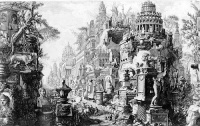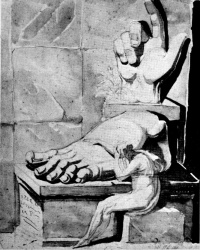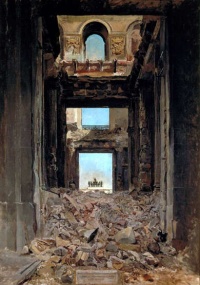Ruins
From The Art and Popular Culture Encyclopedia
|
Related e |
|
Featured: |
Ruins is a term used to describe the remains of man-made architecture: structures that were at one time complete but which have either been deliberately destroyed or fallen into a state of disrepair over time due to the action of weathering and lack of maintenance.
There are famous ruins all over the world, from ancient sites in Judea to ancient Greek and Roman sites in the Mediterranean Sea, and Incan sites in Peru. Ruins can be fortifications, places of worship, or remnants of houses, storehouses, or other buildings, or even entire cities and towns. Ruins are important for the studying of the past, in particular history and archaeology. There are also substantial ruins in modern cities such as Rome and Athens.
Ruins often occur as a result of natural disaster, war or other forms of depopulation. Numerous great historic buildings in Europe have fallen into ruin from taxation policies, which required all structures with roofs to pay substantial taxes. This outcome occurred for Fetteresso Castle and Slains Castle in Scotland, although the former is since restored. Ruins can also derive from official decrees of government, such as the case of Beverston Castle, where the English parliament ordered significant destruction of the castle to prevent it being used by the opposition Royalists. European cities were in ruins after World War II, especially Berlin, London, Coventry and Dresden.
Ruins are often romanticized in literature, art and film, and often provide a backdrop for other forms of decline or decay. For example, the ruined Dunnottar Castle in Scotland was used for filming of Hamlet starring Mel Gibson and Glenn Close, while the ruins of Dunstanburgh Castle in England inspired Turner to create several paintings.
Contents |
Aesthetics
In the Middle Ages Roman ruins were inconvenient impediments to modern life, quarries for pre-shaped blocks for building projects, or of marble to be burnt for agricultural lime, and subjects for satisfying commentaries on the triumph of Christianity and the general sense of the world's decay, in what was assumed to be its last age, before the Second Coming. With the Renaissance, ruins took on new roles among a cultural elite, as examples for a consciously revived and purified architecture all' antica, and for a new aesthetic appreciation of their innate beauty as objects of venerable decay. The chance discovery of Nero's Domus Aurea at the turn of the sixteenth century, and the early excavations at Herculaneum and Pompeii had marked effects on current architectural styles, in Raphael's Rooms at the Vatican and in neoclassical interiors, respectively. The new sense of historicism that accompanied neoclassicism led some artists and designers to conceive of the modern classicising monuments of their own day as they would one day appear as ruins.
Ruin value
Ruin value is the concept that a building be designed such that if it eventually collapsed, it would leave behind aesthetically pleasing ruins that would last far longer without any maintenance at all. Joseph Michael Gandy completed for Sir John Soane in 1832 an atmospheric watercolor of the architect's vast Bank of England rotunda as a picturesquely overgrown ruin, that is an icon of Romanticism. Ruinenwert was popularized in the 20th century by Albert Speer while planning for the 1936 Summer Olympics and published as Die Ruinenwerttheorie ("The Theory of Ruin Value").
In painting and photography
Ruins remain a popular subject for painting and creative photography and are often romanticized in film and literature, providing scenic backdrops or used as metaphors for other forms of decline or decay. For example, the ruins of Dunstanburgh Castle in England inspired Turner to create several paintings; in 1989 the ruined Dunnottar Castle in Scotland was used for filming of Hamlet. The Civilization series of turn-based strategy computer games features ruins as special tiles which may provide the player with a bonus when explored.
Examples
- Classical Ruins[1] (1798) is a painting by French artist Hubert Robert.
- A capriccio of classical ruins with figures [2] by Leonardo Coccorante (1680–1750)
Folly
Ruins are frequently present in architectural follies. The canonical examples pretend to be the remains of an old building but which was in fact constructed in that state. Many old estates had ruins of monastic houses (in England) and Roman villas (in Italy). See Ruinenberg at Sanssouci. A contemporary example is Piazza d'Italia.
Relics of steel and wooden towers
As a rule, towers built of steel are dismantled, when not used any more, because their construction can be either rebuilt on a new site or if state of construction does not allow a direct reuse, the metal can be recycled economically. However sometimes tower basements remain, because their removal can sometimes be expensive. One example of such a basement is the basement of the former radio mast of Deutschlandsender Herzberg/Elster.
The basements of large wooden towers such as transmitter Ismaning may also be left behind, because removing them would be difficult.
See also
- Capriccio (art)
- List of vedutisti
- "Ozymandias"
- Folly (architecture)
- Dissolution of the monasteries
- Shipwreck



_-_B._Bellotto.jpg)



